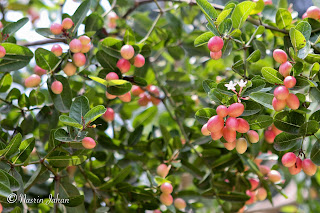 |
| Koromcha |
Koromcha (Carissa carandas) is a tasty fruit of Bangladesh. Koromcha is growing perfectly
Southeast Asia. This climate is very productivity place in the
world. There Bangladesh have a famous Bengali folk poem –"নেবুর পাতা করমচা যা বৃষ্টি থেমে যা" This tree not long it is medium size. The
tree is a semi vine shrub, about 10-12 feet high (3-4 meter) with
small spines at the stalk of leaves. Semi vine means it needs a little
support to stand up.
The plant is grown from seed sown in August and September. Vegetative propagation also is practiced in the form of budding and in-arching.
Cuttings may also succeed. The first monsoon shower is planting time.
Plants raised from seed start bearing two years after planting.
Flowering starts in March and in Northern India the fruit ripens from
July to September.
Leaves - opposite, obovte to oblong, cuneate base, obtuse apex, entire margin.
Trunk - simple spines at alternate nodes; milky latex.
Flowers - white or pink, in 3's, in axillary and terminal clusters.
Fruits - reddish purple berries.
 |
| Koromcha |
Carissa carandas is a species of flowering shrub in the dogbane family, Apocynaceae. It produces berry-sized fruits photo that are commonly used as a condiment in Indian pickles and spices. It is a hardy, drought-tolerant plant that thrives well in a wide range of soils. Common names include karonda (Devanagari: करोंदा), karamardaka (Sanskrit), kauLi hannu /ಕೌಳಿ ಹಣ್ಣು (Kannada), kali maina/कालि मैना (Marathi), vakkay (Telugu), maha karamba/මහ කරඹ (sinhala), kilaakkaai/கிளாக்காய் (Tamil). Other names less widely used include: karau(n)da, karanda, or karamda.[1][2] It is called kerenda in Malaya, karaunda in Malaya and India; Bengal currant or Christ's thorn in South India; nam phrom, or namdaeng in Thailand; and caramba, caranda, caraunda and perunkila in the Philippines.[3] In Assam it is called Karja tenga. In Bengali it is called as Koromcha.
The atmosphere of the Southeast Asia is best to grow koromcha (karanda) plant. It becomes all over in our nation. Blossoms come at ahead of schedule in the spring (February/March) with little scent. They are around three quarter inches in lengths and white in shading. Organic products full grown from May to August. They are about the same size of their blossom in lengths and one inch in breadths. They change their shading all through their development first green before long white, at last blood red shading (from where the name 'Ruby Fruit' presumably determined).
Koromcha natural products have a biting taste. In the wake of getting completely ready, they get to be middle of the road sharp. They are brimming with Vitamin C with a lot of Iron which is exceptionally helpful to cure sickliness. They are understood for making Jelly and Jam. Mouth watering pickles are additionally produced using koromcha organic products. They likewise generally utilized as a part of Ayurvedic pharmaceutical in Indian subcontinent.
The supposed varieties congesta and paucinervia actually refer to the related conkerberry.
For my other blogs. Please pay a CLICK HERE
The atmosphere of the Southeast Asia is best to grow koromcha (karanda) plant. It becomes all over in our nation. Blossoms come at ahead of schedule in the spring (February/March) with little scent. They are around three quarter inches in lengths and white in shading. Organic products full grown from May to August. They are about the same size of their blossom in lengths and one inch in breadths. They change their shading all through their development first green before long white, at last blood red shading (from where the name 'Ruby Fruit' presumably determined).
 |
| Deshi Koromcha |
The supposed varieties congesta and paucinervia actually refer to the related conkerberry.
For my other blogs. Please pay a CLICK HERE

Hi, I have seen your post and I liked it very much. I like Bangladeshi fruits specially Mangoes, Jackfruits, Blackberry etc. I am with the Camel Trekking Tours in Morocco. I will come back soon and will visit your site again.
ReplyDeleteHi, I have seen your post, i like jackfruits & koromcha very much.Speacially koromcha is my favourite.
ReplyDeleteThanks a lot Bipa for your comment. If you come to my village home you will see Koromcha tree and orchard there.
DeleteKoromcha, Very rare fruit I have seen ever. thankyou for the post.
DeleteThanks Sady for your good comment.
Deletevery nice blog post
ReplyDeleteHi Monoroma dot bd, thanks for your comment. I didn't found your profile. You should keep working on your profile as well as your blog.
DeleteHi,
ReplyDeleteI have seen your blog and found it is very much informative. I like to see more posts in future.
Thanks.
Thanks for your comments...I will try my best to post new items in a few days...
DeleteHi, I have seen your blog site. And I like fruits specially Bangladeshi fruits. At this moment I want to Travel to Cox's Bazar. After visiting Cox's Bazar I will take another look on your blog. Carry on please. I want more posts in your site.
ReplyDeleteThe taste of Rajshahi mango is delicious and authentic.
ReplyDeleteIf you want to get pure mango from Rajshahi, the আম বাজার market wants to give you the best quality mango.
Check it out then you'll decide.